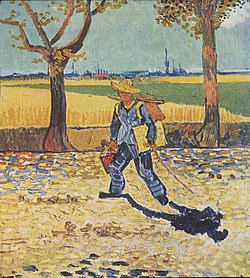| The Painter on the Road to Tarascon | |
|---|---|
 | |
| Artist | Vincent van Gogh |
| Year | 1888 |
| Medium | Oil-on-canvas |
| Movement | Post-Impressionism |
| Condition | Destroyed in bombing |
| Location | Kaiser Fredrich Museum, Stassfurt (until 1945) |
The Painter on the Road to Tarascon, also known as Painter on His Way to Work, is a 1888 painting by Vincent van Gogh that is believed to have been destroyed during the Second World War during an air raid on Germany. [1]